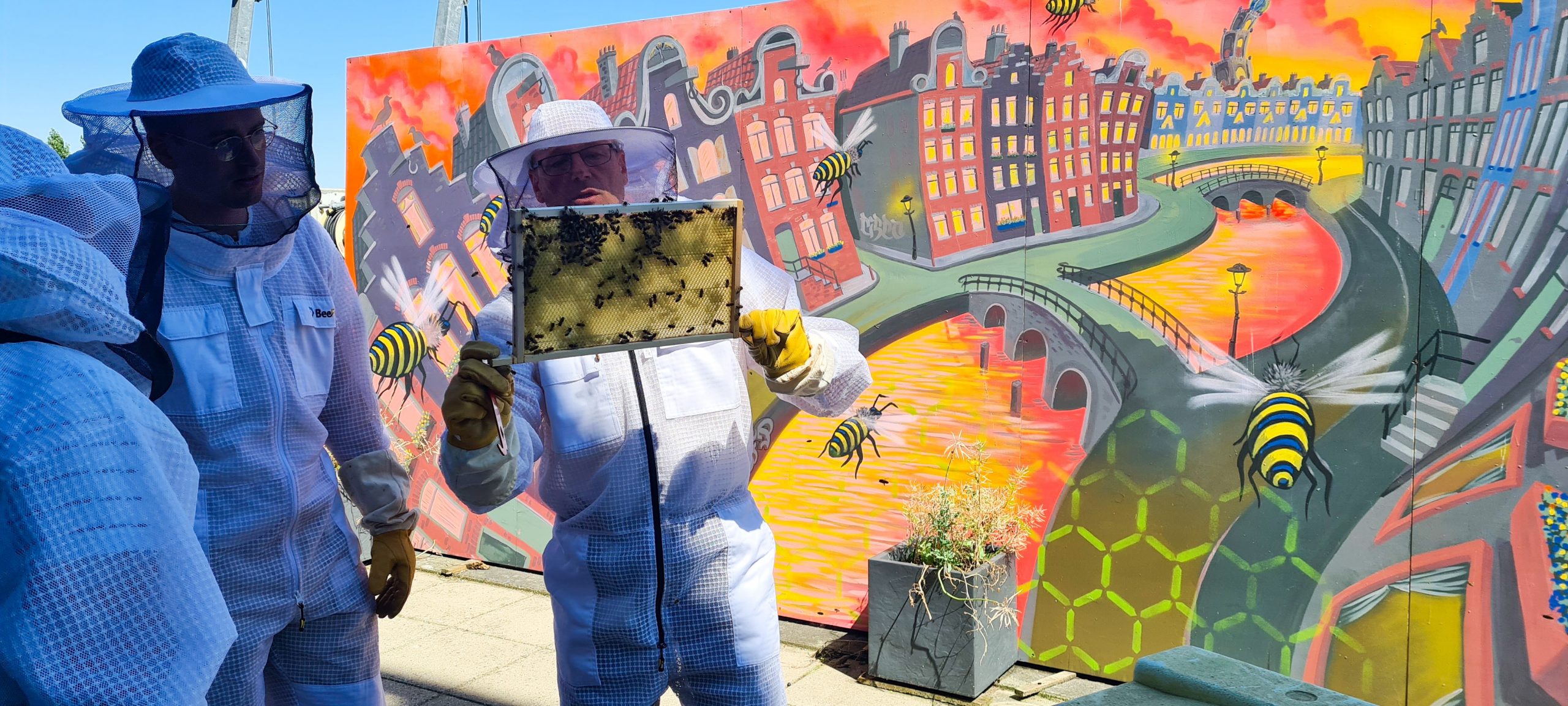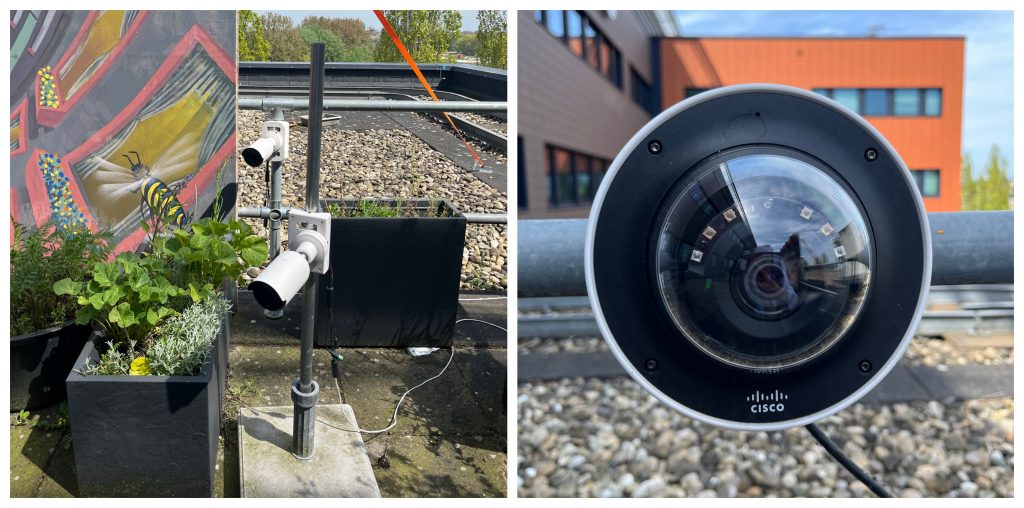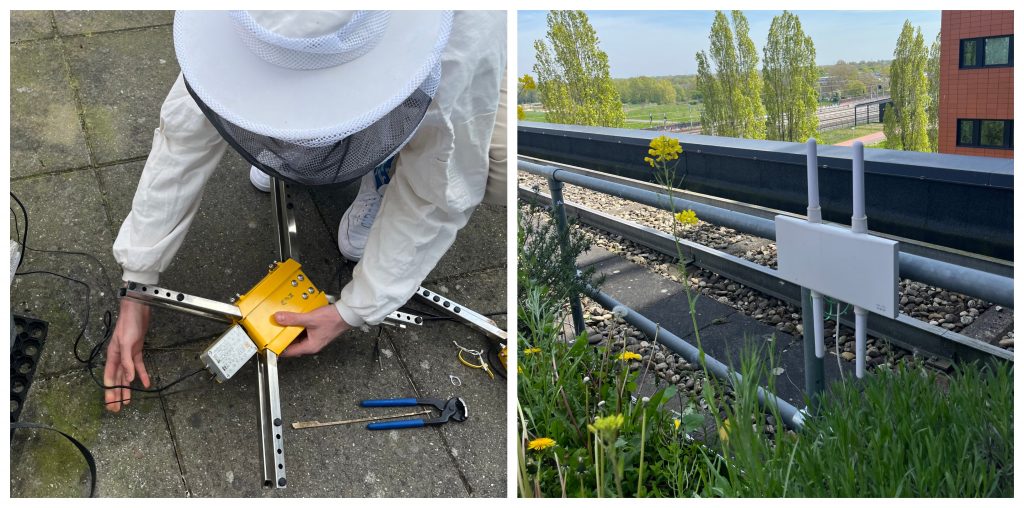World Bee Day: Meet Cisco’s Connected Bees in Amsterdam

We have already shared a lot about the beehives at Cisco’s Research Triangle Park (RTP) North Carolina campus on this blog. Now it is time to buzz across the Atlantic Ocean and learn more about the sweet things we are doing with technology and bees at Cisco Amsterdam.
Many Cisco employees feel a responsibility to protect the natural world and its species. That’s why employees at the Amsterdam campus have established a rooftop beehive and are even integrating technology into the hive.
Bees in the Netherlands
More than 360 different species of bees are known to exist in the Netherlands. Only one of these is the well-known honeybee. This is a bit of a special case, because they hardly occur in the wild in the Netherlands. People benefit daily from the work of insects like bees, also called pollinators. About 4 out of 5 food crops in Europe are dependent on pollination by these insects. Despite the important role that honeybees play in our lives and food systems, half of the bee species in the Netherlands are on the red list of endangered species.
Globally, close to 35 percent of invertebrate pollinators, particularly bees and butterflies, face extinction, according to the Food and Agriculture Organization (FAO) of the United Nations.
Amsterdam beehive
The beehive at Cisco’s Amsterdam office has been there since 2012. The beehive is located on the roof and is maintained and monitored by Cisco employees who volunteer to take care of it. The presence of the beehive provides an opportunity for employees to learn more about the fascinating world of bees and get hands-on experience with beekeeping. Some examples of the activities that the bee team does: maintaining the beehive, bulb planting, and raising awareness about the bees.

Being the innovators that we are at Cisco, there has also been a focus on how the beehive can benefit from technology. Throughout the years the beehive has become more and more connected, using Cisco’s own technology and sensors.
“Being with our honeybees is a fantastic sensory experience; the smell of honey and wax, the buzz of a beehive at the height of summer is unbelievable. It has taught us to observe and appreciate the intricate relationships between the bees and their surroundings, and the importance of protecting biodiversity. It is wonderful to share the experience and awareness with colleagues, customers and their family members that have visited the Connected Bees on the roof of the Amsterdam office.” – Arjan Zoodsma, Success Program Manager for EMEA North
Connected beehive – Smart “buildings” for bees
Humans have the technology to make our buildings smart and connected, but could bees benefit from a connected space, too? It turns out the answer is “Yes!”
A connected beehive that can measure temperature and keep track of bees with cameras shares similarities with a smart building in terms of its use of technology for optimization and efficiency. Just as a smart building uses sensors to monitor and regulate temperature, lighting, and other environmental factors, a connected beehive uses sensors to measure the temperature and humidity inside the hive. Both smart buildings and a connected beehive demonstrate how technology can be used to improve the functionality and sustainability of living systems.

The technology that keeps our beehive connected
In the Cisco beehive, every time the door to the roof opens, an alert is sent to a Webex room to notify that someone is near the beehive. The alert is sent thanks to a Meraki MT20 sensor on the door, which was placed there during the pandemic when it was difficult to get multiple people to the office for a beehive check. To make sure it was still possible to continue the beehive checks during the pandemic, the sensor was installed. Now that we’re returning to our office, the technology is still being used and has been beneficial for a team where work is hybrid and employees are not always in the office physically to check on the bees.
Next to the door sensor, there are four Meraki cameras on the roof. Two of them provide a view of the beehive from a bit further away, so we can see what is happening around the beehive. The third and fourth camera, Meraki MV5’s, are placed in front of the beehive opening and provide a zoomed-in view. This angle allows us to see exactly what’s going on at the entrance of the hive in real-time.

We achieve the real-time sharing of sensor data with a backbone of Meraki networking gear. The MR76 access point, MX67 router, and MS 120 switch are also installed on the roof next to the beehive. The AP’s enable wireless connectivity for the sensors, the MS120 switch provides Power over Ethernet for the sensors, as well as wired connectivity, and the router makes it possible to access the ‘beehive network’ from across the world through the internet.
Inside the beehive is a BEEP base automatic measurement system, which can monitor the weight, temperature, sound frequency, and humidity in the hive. All of this can be monitored through a dashboard, and we can keep a close eye on what the conditions inside the hive are like.

Technology like this could be used in other ways to efficiently connect to other things as well. For example, think about the plants in your office. By placing a sensor in the pots, you can easily keep track of how your plants are doing and whether they need water.
Interested in Starting your own hive?
Here’s 5 steps you can take to get started on your own connected beehive:
- Find a location. The hive should be placed in a location that is safe, easily accessible, and receives plenty of sunlight. It should also be away from foot traffic and any potential sources of disturbance. Good options include a rooftop or (private) garden.
- Obtain necessary permits. Depending on your location, you may need to obtain a permit to keep bees close to neighbors or near a public road. Inform yourself of local regulations to see what permits are required. Additionally, reach out to other local beekeepers to gain locally relevant information.
- Create a safety plan. Create a list of gear needed for your volunteers. Set up a list of emergency procedures and purchase necessary safety items. Inform nearby institutions and neighbors about your plans for the hive.
- Prepare and educate. To prepare and educate volunteers to work with a beehive, provide training, familiarize them with a hive and its bees, demonstrate proper techniques, and review safety procedures.
- Obtain bees and a hive. There are many different types of bees and hives to choose from. It’s a good idea to do some research. Reach out to local beekeepers or beekeeping organizations to best obtain bees. This will help you obtain the best bees for the local circumstances, the best hive to work with, or potentially obtain a swarm from another beekeeper.
- Monitor the hive. Regularly check on the hive to ensure the bees are healthy and the hive is functioning properly. Tasks include making sure they have enough space and food, harvesting honey, and adding hive boxes. Additionally, you can create a connected beehive with sensors and cameras to monitor the hive remotely and get real-time data and images.
Share:

